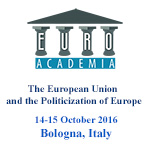Euroacademia Conferences
 Europe Inside-Out: Europe and Europeanness Exposed to Plural Observers (9th Edition) April 24 - 25, 2020
Europe Inside-Out: Europe and Europeanness Exposed to Plural Observers (9th Edition) April 24 - 25, 2020 Identities and Identifications: Politicized Uses of Collective Identities (9th Edition) June 12 - 13, 2020
Identities and Identifications: Politicized Uses of Collective Identities (9th Edition) June 12 - 13, 2020 8th Forum of Critical Studies: Asking Big Questions Again January 24 - 25, 2020
8th Forum of Critical Studies: Asking Big Questions Again January 24 - 25, 2020 Re-Inventing Eastern Europe (7th Edition) December 13 - 14, 2019
Re-Inventing Eastern Europe (7th Edition) December 13 - 14, 2019 The European Union and the Politicization of Europe (8th Edition) October 25 - 26, 2019
The European Union and the Politicization of Europe (8th Edition) October 25 - 26, 2019 Identities and Identifications: Politicized Uses of Collective Identities (8th Edition) June 28 - 29, 2019
Identities and Identifications: Politicized Uses of Collective Identities (8th Edition) June 28 - 29, 2019 The European Union and the Politicization of Europe (7th Edition) January 25 - 26, 2019
The European Union and the Politicization of Europe (7th Edition) January 25 - 26, 2019 7th Forum of Critical Studies: Asking Big Questions Again November 23 - 24, 2018
7th Forum of Critical Studies: Asking Big Questions Again November 23 - 24, 2018 Europe Inside-Out: Europe and Europeanness Exposed to Plural Observers (8th Edition) September 28 - 30, 2018
Europe Inside-Out: Europe and Europeanness Exposed to Plural Observers (8th Edition) September 28 - 30, 2018 Identities and Identifications: Politicized Uses of Collective Identities (7th Edition) June 14 - 15, 2018
Identities and Identifications: Politicized Uses of Collective Identities (7th Edition) June 14 - 15, 2018
Behind the Synthetic Curtain: The Politics of Plastic in Czechoslovakia
-
-

-
Presentation speakers
- Roksana Filipowska, Doan Fellow, Chemical Heritage Foundation / University of Pennsylvania, USA
- Download presentation
Abstract:
In 1972, the Museum of Decorative Arts in Prague launched “Plastic Design,” a study devoted to surveying the artistic accomplishments of the plastics industry in Czechoslovakia. Rather than culminating in an exhibition of national designs, the Museum’s study resulted in Design A Plastické Hmoty, a book displaying its subject through its neon plastic cover, white plastic two-ring binding, and numerous clear plastic overlays. Identifying the book’s purpose and intended audience poses a challenge: contemporary publishers describe it as “decidedly iron curtain” due to editor Milena Lamarova’s discussion of plastics within the context of Czechoslovakia’s economy, yet there are numerous aspects of the Museum’s project that elude the category of state propaganda. Published at a time when the Museum building was censored and closed for renovation, the book features photographs of Czechoslovak examples alongside designs from such countries as Italy, Denmark, France, and Great Britain. It presents Prague and Bratislava as two dynamic nodes within an international network of designers using new synthetics to revolutionize the built environment. Using Design A Plastické Hmoty as a starting point, I explore the material and cultural importance of plastic and its design within Czechoslovakia’s Fifth Five-Year Plan. My study contextualizes Lamarova’s project within several utopian collaborations between artists and polymer chemists that were shut down after the Soviet invasion of 1968 and the lingering anxiety over plastic’s “capitalist” aesthetic. Focusing on furniture and home accessory design, I consider how plastics shaped the socialist consumer’s interaction with her changing environment, and examine the role of exhibition catalogue publishing as an act of soft diplomacy.
-
Related Presentations













